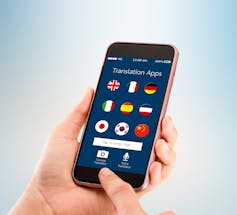
Editor’s Note: This article is penned by a Canadian researcher and makes several references to Canada as a bilingual society. We have shared it with permission here because School News believes its content is relevant and of interest to our NZ educators looking to diversify and expand language learning opportunities for their students. As we prioritise te reo Māori, NZ sign language, and work to better understand language learning in a future-focused context, these conversations are ever more poignant.
Learning a language after one’s early childhood home language is often referred to as second language learning (despite the fact people may in fact be learning their third or fourth languages). In Canada, an officially bilingual country, both English and French are widely taught in superdiverse urban centres.
Increasingly, a popular avenue for adult language learners is mobile language learning via free or cheap downloaded apps. A number of apps for mobile language learning claim top-market share: Duolingo claims to teach 200 million language learners worldwide; Busuu, 90 million learners; Babbel and Memrise are also major players.
I analyzed these four apps for their approach to and treatment of language and language learning. I found that they relied problematically on past models of what language is and what language does.
How the apps teach grammar

None of these four top-selling apps are capitalizing on how language is changing in online communication where features such as emojis or hashtags — conventions used in texting and tweeting — are fundamentally altering how people communicate.
Rather, these apps tended to teach by testing, drilling vocabulary and simple phrases. Thus, “I read a book” is presented for memorization and contrasted with “she reads a book,” with little if any grammatical explanation.
Grammar is the backbone of a language; it’s the structure that words fit into so they make sense for users of the language. Online grammars have diverged from standard “sentence” grammars, which typified printed texts, in myriad ways.
Language structures meaning
Grammatical study involves chiefly two levels of language structure: elements added to a word (morphology), and the organization of words in a sentence (syntax).
Languages that are organized predominantly according to the order of words in a sentence, such as English, are described as analytic. Languages that put more information on word formation, such as Russian, are described as synthetic.
Some languages are extremely synthetic or polysynthetic, using what’s called “agglutination” to create long sentence-type words that would in an analytic language require many words in a sentence. Agglutination builds meaning by gluing word parts together. An excellent example is the Ojibwe (or Anishinaabe) language (Anishinaabemowin).
For example, in The Mishomis Book: The Voice of the Ojibway, spiritual leader and teacher Edward Benton-Banai breaks down the word Anishinaabe rooted in the people’s creation story: ani (from whence) nishina (lowered) abe (the male of the species).

Ojibwe scholar and historian Alan Corbiere, who developed the Anishinaabemowin Revival Program, explains that adding the final morpheme “-mo” to the word Anishinaabe refers to vocalization and speaking the language.
Adding “-win” to Anishinaabemo, Corbiere explains, renders the verb back to a noun meaning Anishinaabe (Ojibwe) language. Saying the single word Anishinaabemo in English requires an entire phrase (“speaking the Ojibwe language”)!
This grammatical lesson is particularly interesting because digital word-like conventions, such as #OscarsSoWhite, follow the rules of agglutination. These rules are different from the grammatical patterning of print-era English, which would require something like: “The Oscars are biased towards whites.”
Digital shifts
Word-like forms such as #topic or @onlinehandle are instantly understood as typical communication in their respective digital genres. Moreover, these digital forms are crossing over from online platforms into paper media: see #MeToo headlines in the New York Times, the Telegraph and the Globe and Mail.
Circulating #hashtags carry coherent packages of information, such as #nolitetebastardescarborundorum. This feminist rallying cry hashtag agglutinates (nonsense) words that reference a fake Latin phrase that came to pop culture prominence with the popularity of Margaret Atwood’s The Handmaid’s Tale.
On Twitter, users learn the forms and boundaries of tweet grammar, limited by characters (280), not words. Tweets, like texts, use abbreviations in grammatically systematic ways, such as RT for retweet or DM for direct message.
Texting functions as a conversation that is typed at the speed of speech — otherwise it would not work as a quick, unedited speech bubble. Emojis in texts suggest the way digital users can share pictorial and graphic information alone or with words to show instantly readable emotional nuances: consider OMG😂 (with a laughing-face emoji) versus OMG😡 (with an angry-face emoji).
Impact on language learning
Most second-language teaching, even that in mobile apps, continues to focus on old-school grammar according to print, not digital, conventions. Grammar instruction, which has faded considerably in formal grade school education, is still alive and well in second-language teaching and particularly testing.
Such instruction ignores the creative interactive language that happens in digital exchange, which is breaking the old mould describing how English grammar works. Language instruction programs need to acknowledge that new word shapes and grammar forms are here to stay and use them in language teaching and learning. Language learners would then be able to lean on cross-linguistic elements such as: #, @ and 😊 (happy face).
All grammars adjust with changing language use over time and through usage in particular contexts. We may not use English quite the way that Shakespeare did, methinks, but we can look to his early modern update on Chaucer’s me thinketh as evidence that language change is constant.
The #hashtag’s emergence as a new kind of word shape with its own form and spelling conventions is actually restructuring how we build words and meaning in a new way. Why not teach languages the way we actually use them?![]()









